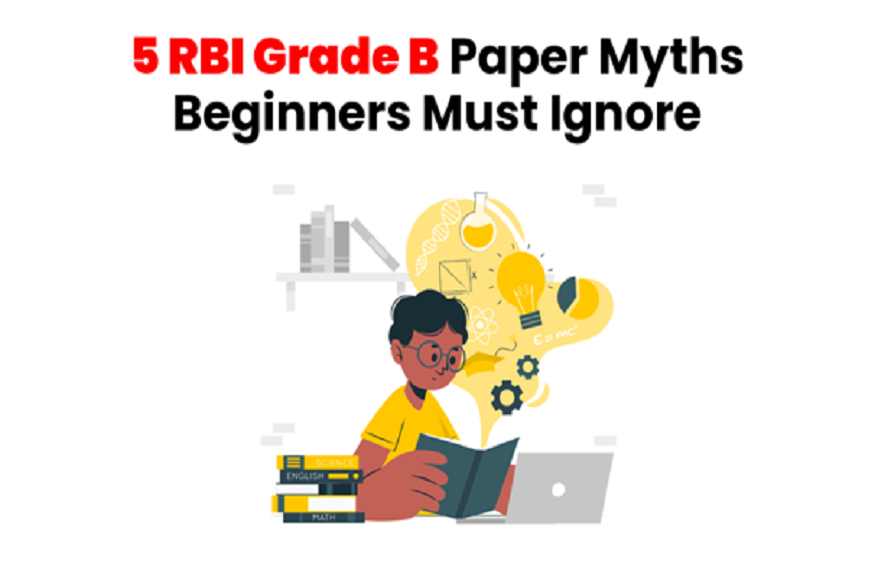
5 RBI Grade B Paper Myths Beginners Must Ignore
If you’ve just started your RBI exam prep and feel confused about what actually matters, you’re not alone. One of the smartest things you can do in the beginning is look at the RBI Grade B previous year question paper.
Yes the syllabus is equally important, but first just start with the previous year question papers. It tells you more about the exam than any topper video or strategy class ever will. Because when you go straight to the source, you stop preparing in fear. You start preparing with focus.
Most of the noise you’ll hear during your preparation “This section is impossible,” “You have to study everything,” “Nobody knows what RBI will ask,” usually comes from people who’ve never studied the paper properly.
And that’s where myths begin. If you want to clear the RBI Grade B exam, you need to think differently from day one. Let’s start with clearing out the clutter. Let’s start by busting some of the biggest myths holding beginners back and give you the truth that actually helps.
Myth 1: “RBI can ask anything – it’s all luck.”
Truth: It’s not random. It’s rigorous.
A lot of beginners assume the RBI Grade B paper is unpredictable, like it’s designed to surprise you. This myth comes from fear. Because the paper doesn’t follow a strict syllabus, students assume it’s random. But when you sit down with the RBI Grade B previous year question paper, a different picture emerges.
RBI doesn’t want you to memorize the entire syllabus, rather it wants to know if you understand how things work and why they matter.
You’ll notice clear patterns:
- A strong bias towards applied understanding (not just facts)
- Preference for clarity over cramming
- Repeated focus areas like inflation, monetary policy, budget terms
The paper isn’t trying to shock you. It’s trying to filter for clarity, curiosity, and conceptual depth.
Myth 2: “Reading the newspaper every day is enough for current affairs.”
Truth: Just reading isn’t enough. You need to understand and connect.
This sounds like smart advice, and yes, reading the newspaper helps. But if you’re only reading headlines every day without really understanding what’s happening or why it matters, it won’t help you much in the exam.
The RBI Grade B previous year question papers show that current affairs questions aren’t just about dates and names. They test your understanding of policies, economic developments, and their impact.
So instead of reading everything, read with a purpose. After going through a news article, ask yourself:
“If RBI asked something from this, what would the question look like?”
That one habit will turn your newspaper time into real preparation. It’s not about reading more, it’s about thinking better.
Myth 3: “Phase 1 is easy. Just qualify and focus on Phase 2.”
Truth: You’ll never reach Phase 2 if you take Phase 1 lightly.
RBI’s Phase 1 isn’t tough because of what it asks. It’s tough because of how little time you get to do it all. Students who ignore this, thinking “I’ll do mocks later,” often don’t make it past this stage.
It’s not about difficulty. It’s about discipline under pressure.
Don’t take Phase 1 lightly. It’s a door and unless you open it, Phase 2 will never happen.
So, when it comes to Phase 1- Respect it. Prepare for it. Practice timed mocks and not just questions.
Myth 4: “You need coaching to crack this paper.”
Truth: You need direction, not dependency.
Coaching helps, only if it guides. But no institute can replace your thinking and commitment.
The syllabus and RBI Grade B previous year question papers are some of the best coaches you can get in your early prep.
They tell you:
- What are the important areas
- What kind of questions matter
- What kind of understanding is tested
- How to filter what’s useful from what’s clutter
You don’t need more PDFs or longer videos. You need better questions and honest self-assessment.
If a coaching class gives you that, great. If not, you need to own your preparation.
Myth 5: “I’ll prepare everything, just in case.”
Truth: When you try to study everything, you remember nothing.
Beginner anxiety often leads to over-preparation. Multiple books per subject. Notes from everywhere. 20 sources for current affairs.
Here’s what actually works:
- Pick one source. Stick to it.
- Study past year papers. See what actually gets asked.
- Focus on core concepts.
In the end, success in RBI comes from clarity, not coverage.
No need to follow the herd- Make your own path
Most aspirants are busy downloading material and joining prep groups. You don’t need more noise, rather you need a strategy that’s aligned with the demands of the exam and works best for you.
Start by focussing on the RBI Grade B previous year question papers and the syllabus. Use it to build a map. Stick to that map. Don’t blindly follow every plan you hear. And above all, think like someone who already works at RBI.


